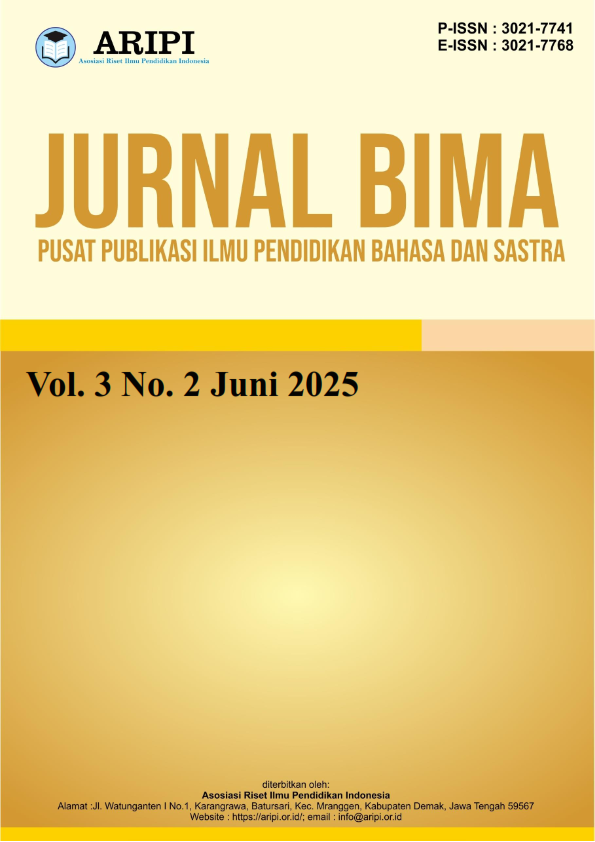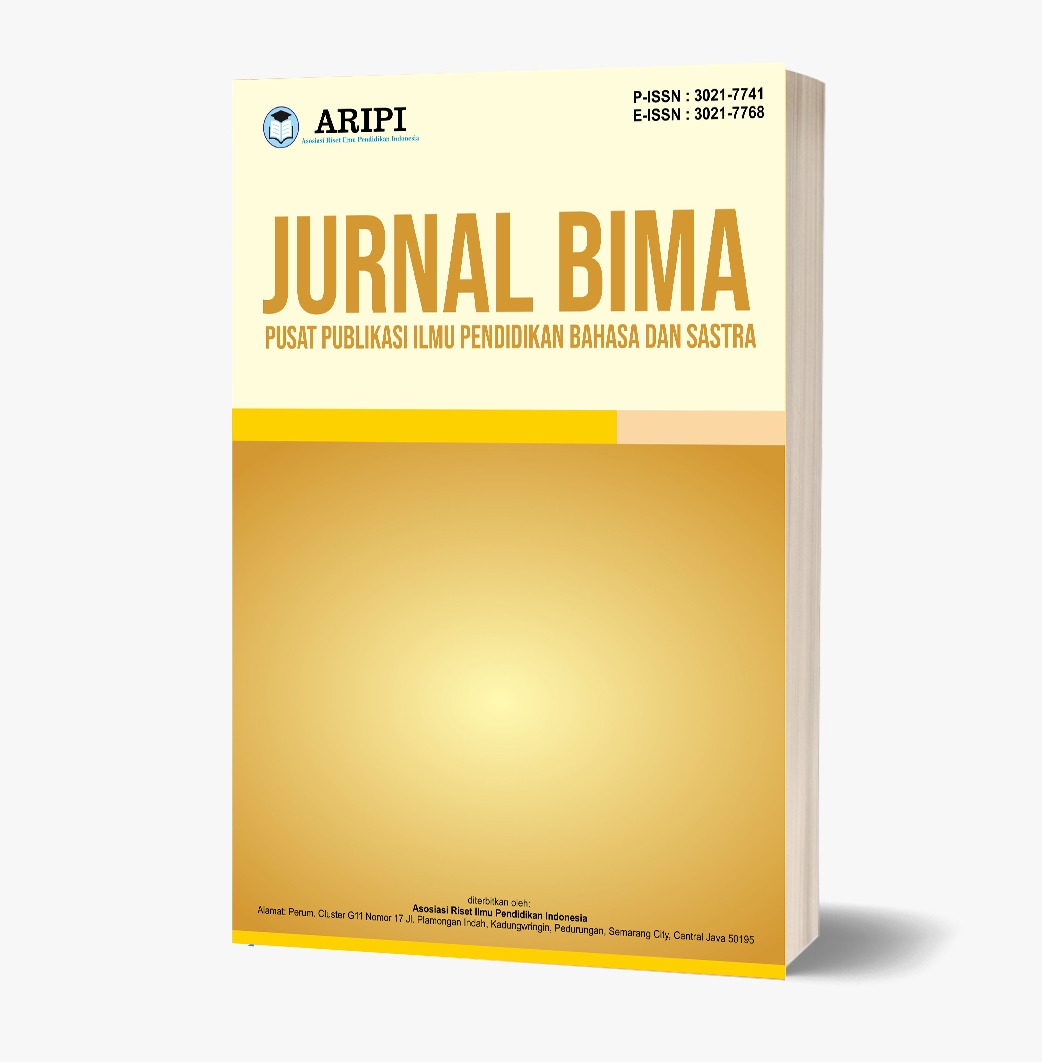Apresiasi Sastra Reseptif : Penerapan Pendekatan Emotif, Didaktis, dan Analitis terhadap Sastra Anak
DOI:
https://doi.org/10.61132/bima.v3i2.1744Keywords:
Analytical Approach, Didactic Approach, Emotive Approach, Receptive Literary AppreciationAbstract
This article discusses the application of emotive, didactic, and analytical approaches in receptive literary appreciation of children's literature. Receptive literary appreciation is the initial stage of appreciating literary works, emphasizing the reader's emotional engagement, evaluation, and acceptance of the content, particularly for children. The emotive approach focuses on the emotional and aesthetic elements of the work, the didactic approach highlights the understanding of ideas and moral values, while the analytical approach helps readers comprehend the structure and the author's message. Through the integration of these three approaches, children are expected to develop comprehensive cognitive, affective, and appreciative skills toward literature. The article also emphasizes the importance of appropriate teaching methods to enhance children's interest and understanding of literature, thereby supporting language development, imagination, and life values in children.
Downloads
References
Abrams, G. G. H. (2009). A glossary of literary terms. College Composition and Communication, 8(4). https://doi.org/10.2307/354930
Aminuddin. (2000). Pengantar apresiasi karya sastra. Algesindo. http://repository.unj.ac.id/13858/5/COVER.pdf
Ananda, C. K., Aziz, A. M., Septiani, D., & Harahap, A. H. (2022). Pendekatan REBT (Rational Emotive Behavior Therapy) untuk meningkatkan motivasi belajar siswa. Jurnal Ikatan Alumni Bimbingan dan Konseling Islam, 4(1). http://jurnaltarbiyah.uinsu.ac.id/index.php/almursyid/
Endeh. (2017). Nilai didaktis dalam novel Hujan karya Tere Liye. Jurnal Diksatrasia, 1(2), 164–172. https://jurnal.unigal.ac.id/index.php/diksatrasia/article/viewFile/595/493
Fauziyyah, D. F., & Sumiyadi. (2020). Nilai-nilai didaktis dalam novel Burung-burung Kecil karya Kembangmanggis. Semantik, 9(1), 41–50. https://doi.org/10.22460/semantik.vXiX.XXX
Kartini, A., & Sumiyadi. (2022). Kajian sastra didaktis dalam novel Guru Aini karya Andrea Hirata. Stilistika: Jurnal Pendidikan Bahasa dan Sastra, 15(1), 132–145. http://journal.um-surabaya.ac.id/index.php/Stilistika/index
Kusnita, S., Uli, I., & Yuniarti, N. (2022). Aspek kognitif dalam novel Dunia Anna karya Jostein Gaarder (pendekatan didaktis). Jurnal Pendidikan Bahasa, 11(2), 409–418. http://journal.ikippgriptk.ac.id/index.php/bahasa
Marlina. (2013). Novel Negeri 5 Menara: Sebuah tinjauan didaktis. Jurnal Madah, 4(2), 149–162. https://www.neliti.com/publications/235930/novel-negeri-5-menara-sebuah-tinjauan-didaktis
Repp, C. (2012). What’s wrong with didacticism? The British Journal of Aesthetics, 52(3), 271–285. https://doi.org/10.1093/aesthj/ays023
Ruslan, T. S. (2023). Membaca apresiatif. Langgam Pustaka.
Ruys, J. F. (2008). Introduction: Approaches to didactic literature—Meaning, intent, audience, social effect. Brepols Publishers, 1–38. https://doi.org/10.1484/M.Disput-Eb.3.3245
Semi, A. (1990). Metode penelitian sastra. Angkasa.
Sukasih, S. (2022). Teori dan apresiasi sastra di sekolah dasar. Ideas Publishing.
Sumiyadi. (2014). Pengkajian sastra dan film adaptasinya sebagai bahan peningkatan kompetensi guru Bahasa Indonesia. STKIP Garut.
Suyatno. (2004). Teknik pembelajaran bahasa dan sastra berdasarkan kurikulum berbasis kompetensi. Penerbit SIC. https://books.google.com/books/about/Teknik_pembelajaran_bahasa_dan_sastra_be.html?id=wFTmZwEACAAJ
Tarigan, H. G. (1984). Prinsip-prinsip dasar sastra. Angkasa. https://books.google.co.id/books/about/Prinsip_Prinsip_dasar_Sastra.html?hl=id&id=3pK8GwAACAAJ&redir_esc=y
Tchoshanov, M. (2014). Engineering of learning: Conceptualizing eDidactics. [Institutional Repository], 7(1). https://scholarworks.utep.edu/math_papers/227/
Uli, I., Sulastriana, E., & Hajafiani, D. (2017). Pemanfaatan nilai didaktis dalam novel Supernova: Partikel karya Dewi Lestari sebagai bahan pembelajaran di SMA. Jurnal Edukasi, 15(1), 81–95. https://journal.upgripnk.ac.id/index.php/edukasi/article/download/408/390
Wardani, F. P., & Kurniawan, A. M. (2022). Apresiasi sastra anak SD dalam kehidupan. Dewantara: Jurnal Pendidikan Sosial Humaniora, 1(2), 18–21. https://jurnaluniv45sby.ac.id/index.php/Dewantara/article/view/899
Downloads
Published
How to Cite
Issue
Section
License
Copyright (c) 2025 Jurnal Bima : Pusat Publikasi Ilmu Pendidikan Bahasa dan Sastra

This work is licensed under a Creative Commons Attribution-ShareAlike 4.0 International License.







